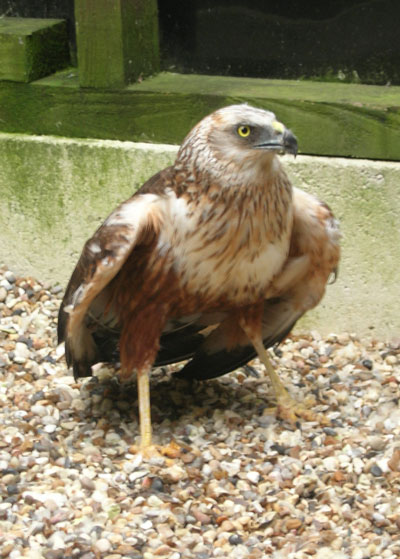Over the past 18 months, the Suffolk Owl Sanctuary has undertaken it’s biggest fundraising drive to date.
The aspiration is to build a new, larger raptor hospital better equipped to deal with the increasing numbers and larger sizes of some of the avian casualties brought into the centre.
Most birds enter the hospital via two routes; either our team go out to rescue birds caught in difficult situations like being trapped in a chimney, or they are brought into the hospital by members of the public, often referred to us by local veterinary practices.
This unfortunate Tawny was rescued from a slurry pit but we were able to clean him up and after a few weeks of recuperation, set him on his way
On arrival at the centre our team are able to assess the severity of the injury or trauma and administer the first aid necessary and frequently-used medication to give the bird some respite before entering rehab.
One of our hospital patients, a buzzard with a severe case of frounce, is crop-tubed - a method of getting liquid food into the stomach when the condition makes it difficult for the bird to ingest food by itself
In more serious cases, such as a broken wing or where a bird may have been shot or poisoned, we take the bird to our veterinary who has the expertise necessary to treat the birds’ injuries in surgery or diagnose more specialist medication as may be required. After treatment, the injured bird is returned us as the vet does not have the time and facilities needed for several weeks’ recuperation and rehabilitation.
Our current hospital facility has stood us in good stead, but the increase in both the number and physical size of the birds we are called upon to care for has determined the need for larger premises.
The fabric of the present hospital facilities was originally very generously donated by Pets At Home in Bury St. Edmunds and equipped with donations from other benefactors. Although hundreds of birds have fortuitously passed through the hospital to be re-released back into their native habitat, still more successful outcomes could be realised with improved and enlarged facilities.
For more serious cases, Paul Canham from the local veterinary practice is called upon to carefully examine birds to determine the likely cause of a problem and then operate as appropriate. Our General Manager Maz lends a hand...
The sanctuary’s hospital is in most demand from May-July when capacity is quickly reached with the springtime influx of baby owls which have fallen from their nests. In most cases, these tiny creatures only need plenty of food, warmth and TLC to equip them for life back in the wild and as baby owls grow EXTREMELY quickly, they outgrow their cosy brooders within a few weeks. Plans for the new hospital include a larger incubator room and increased numbers of brooders and nursery accommodation.
“Baby season” aside, the normal admissions of adult birds into the hospital due to road traffic accidents, chimney falls, hypothermia and starvation still continue through every season. A bigger treatment room and and larger rehabilitation aviaries are also planned, therefore.
This Marsh Harrier is typical of the larger species of wild birds of prey we are now privileged to treat, nurture and re-habilitate
Over the last few months a total of 33 birds have been admitted to the existing raptor hospital with 20 being released back into the wild - a success rate of around 60%. Most casualties were Barn Owls with 11 being admitted. Sadly, due to many of these birds being brought in to us with injuries that had established infections, only 4 could be rehabilitated and returned to the wild.
Of 10 Tawny Owls admitted, however, 9 were successfully treated and re-released, with only one road traffic accident proving fatal. 2 Sparrowhawks were brought to the sanctuary suffering from lack of food and after several weeks of recuperation were both released back to their native habitat. 1 Little Owl, 1 Long Eared Owl (a rarity in our hospital) and 1 Buzzard were also successfully returned to the wild after treatment, as were 2 underweight Kestrels.
Once quite an unusual sight in our treatment rooms, Buzzard populations are now on the increase in this locality and it is with these birds and the native Red Kite, which is also becoming more prolific, in mind that space will be augmented within the new hospital block.
With foundations for the new facilities now prepared and construction of the new hospital set to commence, we look forward to many more successful outcomes for our A & E patients.
Meanwhile, we would like to thank everyone who has contributed to funding this huge but much-needed project over the past months - we hope that you will take the opportunity to visit the sanctuary and witness at first hand the essential work carried out in your name in our hospital. THANK YOU.





